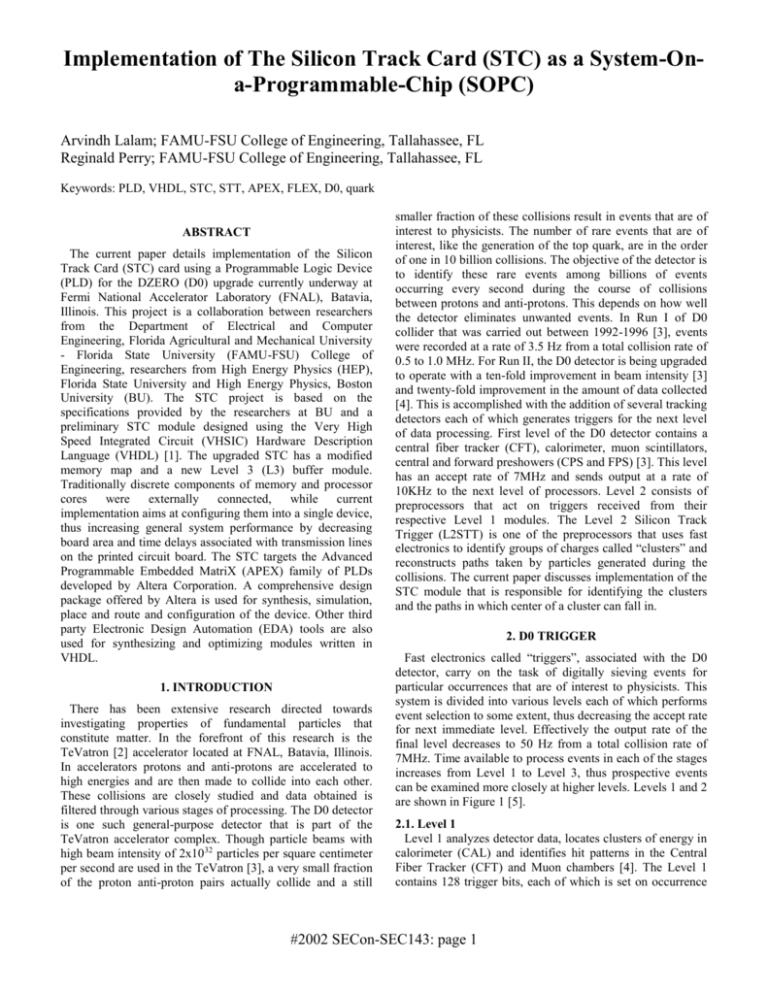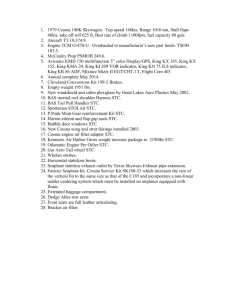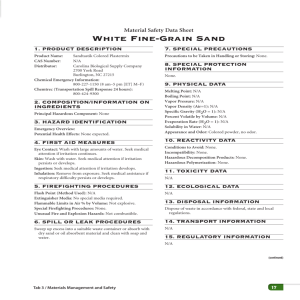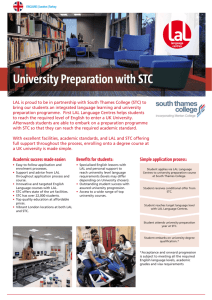stc_sopc_ver_2.2 - FSU High Energy Physics
advertisement

Implementation of The Silicon Track Card (STC) as a System-Ona-Programmable-Chip (SOPC) Arvindh Lalam; FAMU-FSU College of Engineering, Tallahassee, FL Reginald Perry; FAMU-FSU College of Engineering, Tallahassee, FL Keywords: PLD, VHDL, STC, STT, APEX, FLEX, D0, quark ABSTRACT The current paper details implementation of the Silicon Track Card (STC) card using a Programmable Logic Device (PLD) for the DZERO (D0) upgrade currently underway at Fermi National Accelerator Laboratory (FNAL), Batavia, Illinois. This project is a collaboration between researchers from the Department of Electrical and Computer Engineering, Florida Agricultural and Mechanical University - Florida State University (FAMU-FSU) College of Engineering, researchers from High Energy Physics (HEP), Florida State University and High Energy Physics, Boston University (BU). The STC project is based on the specifications provided by the researchers at BU and a preliminary STC module designed using the Very High Speed Integrated Circuit (VHSIC) Hardware Description Language (VHDL) [1]. The upgraded STC has a modified memory map and a new Level 3 (L3) buffer module. Traditionally discrete components of memory and processor cores were externally connected, while current implementation aims at configuring them into a single device, thus increasing general system performance by decreasing board area and time delays associated with transmission lines on the printed circuit board. The STC targets the Advanced Programmable Embedded MatriX (APEX) family of PLDs developed by Altera Corporation. A comprehensive design package offered by Altera is used for synthesis, simulation, place and route and configuration of the device. Other third party Electronic Design Automation (EDA) tools are also used for synthesizing and optimizing modules written in VHDL. 1. INTRODUCTION There has been extensive research directed towards investigating properties of fundamental particles that constitute matter. In the forefront of this research is the TeVatron [2] accelerator located at FNAL, Batavia, Illinois. In accelerators protons and anti-protons are accelerated to high energies and are then made to collide into each other. These collisions are closely studied and data obtained is filtered through various stages of processing. The D0 detector is one such general-purpose detector that is part of the TeVatron accelerator complex. Though particle beams with high beam intensity of 2x1032 particles per square centimeter per second are used in the TeVatron [3], a very small fraction of the proton anti-proton pairs actually collide and a still smaller fraction of these collisions result in events that are of interest to physicists. The number of rare events that are of interest, like the generation of the top quark, are in the order of one in 10 billion collisions. The objective of the detector is to identify these rare events among billions of events occurring every second during the course of collisions between protons and anti-protons. This depends on how well the detector eliminates unwanted events. In Run I of D0 collider that was carried out between 1992-1996 [3], events were recorded at a rate of 3.5 Hz from a total collision rate of 0.5 to 1.0 MHz. For Run II, the D0 detector is being upgraded to operate with a ten-fold improvement in beam intensity [3] and twenty-fold improvement in the amount of data collected [4]. This is accomplished with the addition of several tracking detectors each of which generates triggers for the next level of data processing. First level of the D0 detector contains a central fiber tracker (CFT), calorimeter, muon scintillators, central and forward preshowers (CPS and FPS) [3]. This level has an accept rate of 7MHz and sends output at a rate of 10KHz to the next level of processors. Level 2 consists of preprocessors that act on triggers received from their respective Level 1 modules. The Level 2 Silicon Track Trigger (L2STT) is one of the preprocessors that uses fast electronics to identify groups of charges called “clusters” and reconstructs paths taken by particles generated during the collisions. The current paper discusses implementation of the STC module that is responsible for identifying the clusters and the paths in which center of a cluster can fall in. 2. D0 TRIGGER Fast electronics called “triggers”, associated with the D0 detector, carry on the task of digitally sieving events for particular occurrences that are of interest to physicists. This system is divided into various levels each of which performs event selection to some extent, thus decreasing the accept rate for next immediate level. Effectively the output rate of the final level decreases to 50 Hz from a total collision rate of 7MHz. Time available to process events in each of the stages increases from Level 1 to Level 3, thus prospective events can be examined more closely at higher levels. Levels 1 and 2 are shown in Figure 1 [5]. 2.1. Level 1 Level 1 analyzes detector data, locates clusters of energy in calorimeter (CAL) and identifies hit patterns in the Central Fiber Tracker (CFT) and Muon chambers [4]. The Level 1 contains 128 trigger bits, each of which is set on occurrence #2002 SECon-SEC143: page 1 of a particular combination of trigger terms [3]. An example of triggering combination is a track candidate in the central fiber tracker having energy more than a particular threshold [6]. If any of the 128 trigger bits are set, then the Level 1 sends a Level 1-accept signal and the corresponding event to the Level 2 for subsequent processing. In addition, Level 1 also contains Silicon Micro-strip Tracker (SMT) that captures data to be sent to L2STT [5]. The SMT consists of rectangular silicon p-n junctions. On generation of an electron-hole pair due to the passage of charged particles, the charge is collected by the junctions also known as “strips” and deposited in an array of 32 capacitors [the]. These are connected to Analog-to-Digital Converter (ADC) and the digitized data is sent through an optical link to the next trigger [the]. The output rate from Level 1 to Level 2 is 10KHz. obtained from FRC and STC. Reconstructed parameters are then sent to the L2 Central Tracking Trigger (L2CTT) [4]. L1 CTT SMT STC Cluster Finder FRC Hit filter L3 TFC FRC L2CTT Detector Level 1 Level2 DD DD DD CAL FPS/ CPS L1 CAL L1 CTT L2 Cal L2 PS L2 CFT CFT Figure 2. Block diagram of STT L2 Global Level 3 SMT L2 STT L1 Muon Muon FPD 2.3. Level 3 Level 3 is the final level of the D0 trigger. Upon receipt of a Level_2 accept, Level 3 receives data from Level 1 and Level 2 modules for further processing. This stage is implemented in software unlike other levels and uses parallel fast processors to achieve the processing rate required [3]. Output rate of this final stage is 50 Hz. Output of Level 3 is stored on tape for later application [3]. 3. SILICON TRACK CARD L2 Muon L1 FPD L1 Framework Figure 1. Level 1 and Level 2 of D0 trigger. [5]. 2.2. Level 2 Level 2 improves the accept rate of the events by a factor of ten. This level has access to more refined information than Level 1 and processes data in two stages. First stage consists of preprocessors that analyze data sent by corresponding modules in Level 1. All the preprocessors send data to the Level 2 global processor (second stage of Level 2), which makes a decision of selecting or rejecting the events. This is where data from various modules is combined for the first time. L2STT is one of the preprocessors and is organized into the Fiber Road Card (FRC), STC and Track Fit Card (TFC) [6] as shown in Figure 2. The FRC receives information from the Level 1 CFT and generates particle trajectory information called “roads” for the SMT layers. As shown in Figure 3 [4], the data from various layers of CFT are used to define a road which passes through the SMT layers. Obtained road information is sent to the STC. The operation of STC is discussed in detail in Section 3. The TFC uses eight TI320C6203 300MHz Digital Signal Processors (DSP) for reconstructing the trajectory parameters using the data The STC card is part of the L2STT as shown in Figure 2. The STC card consists of “control logic” and eight STC modules, also called “channels”. The control logic designed by engineers at BU acts as an interface between the STC and the rest of STT. Charges identified in the SMT are sent to the STC in digitized form, called “strip” information. The information sent by Level 1 CFT is used by the FRC to define roads each of which represents a path 2 mm wide as shown in Figure 3. The function of each STC is to organize the strip information into groups called “clusters” and finding the centers of these clusters. In addition, STC performs the task of identifying the cluster centers that fall into any of the roads. Figure 3 [4] shows a group of clusters identified by STC and highlights the clusters that fall into the roads. The STC constitutes a main data path, miscellaneous memory block and L3 buffers as shown in Figure 4. 3.1. Main data path The Main Data Path is indicated in Figure 4 as shaded regions. This has three major parts as described below: Strip Reader Module. This module accepts the SMT strip information in the form of a byte stream arriving at a rate of 53MHz and formats it into an 18bit word. Input byte stream alternatively contains strip address and strip data along with error bits, which are set for erroneous bytes. Strip address and data bytes are stored along with respective error bits into an 18-bit “strip word”. These strip words are readout at a frequency of 32 MHz. There is a possibility that some of the strips will be damaged or will need gain and offset #2002 SECon-SEC143: page 2 compensation. Look Up Tables (LUTs) are used to identify bad strips and to perform gain and offset compensation for good strips. Bad channel LUT identifies damaged strips, while gain offset LUT holds the gain and offset compensated data for each strip. The valid data words thus obtained are stored in a FIFO for later use by the clustering module. logic for reading out the hits from them. Figure 5.1 shows an instance of control logic reading out hits from two STC channels. 3.2. L3 Buffers. In addition to clustering and finding centroids, the STC also needs to buffer intermediate information throughout the processing of an event. l3_config is a 13-bit word that is used to selectively activate L3 buffering for required channels. Every event is initiated by an “event_start” signal upon which l3_config is latched. L3 buffer module also allows buffered data to be read independently using ‘start_l3’ word. start_l3 is a 10-bit word that can be used to readout buffered data from selected channels. Since there are a total of eight channels that process data, a contention scheme very similar to the one used for hit readout is used to control data transfer from L3 buffers. When an L3 block is ready for readout, the corresponding STC pulls up its l3_busy signal and waits for data bus to become available. When bus becomes available, l3_block signal is set high to block the bus from being used by other channels until whole block of data is read. Types of data that each of channels can store are hits, raw data, corrected data, strip of cluster and bad strips. Memory Block PCI3 32 Figure 3. Diagram showing a road and cluster selection [4]. SMT Cluster Finder Module. The clustering module organizes the strips into “clusters” and finds the cluster’s center. This module organizes strips such that the strip with the highest data is placed in the center while the strips immediately before and after this are arranged on either side in the same order. The clustering module can find either a five-strip or a three-strip cluster. An event can have more than one cluster depending on the type of strips and on the continuity of the strip addresses. The centroid finder algorithm is implemented as an asynchronous module that takes the strip data from the clusters determined by the clustering module. This calculation is centered on the second strip. The final value has an additional two bits added for precision. This module uses the following expressions to calculate the centroid for fivestrip and three-strip clusters [6] with D1, D2, D3, D4 and D5 representing strip data: D1 D3 2D4 3D5 D1 D2 D3 D4 D5 D2 D4 Three strip centroid D2 D3 D4 Five strip centroid Hit Filter. The hit filter has a comparator module that checks if any of the found cluster centers fall in the roads. A maximum of 46 roads can be stored in the hit filter for this purpose. A centroid that fits into any of the stored roads is called a “hit” and is stored along with the road into which it fits. This hit information is written along with a header and a trailer for further readout. Since the STC card contains eight STC channels, a contension scheme is used by the control Strip Reader 8 Cluster Finder 23 Hit filter 19 Hit 32 L3 buffer L3 readout Figure 4. STC and Main data path. 4. PROGRAMMABLE LOGIC DEVICES The field of logic devices has evolved from traditional approach of using Transistor-Transistor Logic (TTL) gates for assembling bigger circuits to Integrated Circuits (IC) that have millions of closely packed logic gates. This has seen growth from Small-scale integration (SSI) to Very large scale integration (VLSI) and Ultra Large Scale Integration (ULSI). Application Specific Integrated Circuits (ASICs) are highdensity logic devices making their presence felt in this field. ASICs can be designed either by building right from scratch by optimizing various parameters for a specific application or by piecing non-optimal devices together. This offers better performance characteristics specific to a particular application but is very inflexible. This requires designers to make critical decisions far ahead in the design process and leaves little room to accommodate any changes at later stage. Though PLDs can be considered a branch of ASIC, they have distinct advantages. They introduce a new dimension, programmability, to ICs and allow designers to accommodate changes even in later stages of design. ASICs that have the required memory and logic components in one chip are called #2002 SECon-SEC143: page 3 System-on-chips (SOCs). With addition of programmability, these form a new breed of chips called System-on-aprogrammable-chip (SOPC). These offer flexibility with high density of up to 10 million gates. Preliminary versions of the STC were implemented in Altera’s FLEX10KE CPLDs and required three such CPLDs. Next generation of PLDs, the APEX family, offered by Altera underwent a shift in its basic architecture with inclusion of gate arrays in its ICs by placing logic blocks in a matrix of horizontal and vertical interconnects. These devices allow designers to implement SOPC solutions. Waveforms on Logic Analyzer’s display were stored during various stages of testing. General performance of STC in terms of time taken from start of the event till hit readout can be observed from waveform in Figure 5.1. Spikes seen in signal ‘hc_wr’ in Figure 5.1 show write pulses generated for hits and centroids. Figure 5.2 shows operation of both the STC channels while control logic reads out hits and centroids. This is magnified waveform, thus pulses of ‘hc_wr’ look wider in this figure. It can be observed that, at any time pulses can be observed in only one of the two ‘hc_wr’ lines thus avoiding contention. 5. IMPLEMENTATION Usage of three different CPLDs consumes a lot of board area and involves extensive delays between various modules. Thus APEX EP20K600EBC-1 was chosen to configure the whole module into a single device. This offers as many as 600,000 typical gates and a maximum of 311,296 RAM bits and is supported by the Quartus development package [7], an integrated package offering a whole range of tools from VHDL entry to configuring the devices. Preliminary implementations of individual modules of the STC were carried out on Altera’s SOPC development board that houses an APEX EP20K400E-1 chip along with other memories. Initial debugging of STC was done by using Altera’s signal tap logic analyzer. Signal tap allows internal signals on the board to be monitored in Quartus. The Next stage of testing and debugging of the STC was done along with ‘control module’ designed using Altera’s FLEX EP10K130EFC484-1. A Prototype PCB was custom designed to test the two STC channels operating simultaneously. This prototype board also houses the controlling module. All the PLDs on the board are in-system programmable. These can be programmed through a Joint Test Action Group (JTAG) interface [8]. The contention scheme used in hit and centroid readout and performance of the STC can be observed using this board. A Logic Analyzer was used to observe waveforms during operation of the board. Figure 5.2 Magnified view of hit and centroid readout. CONCLUSION The STC module was successfully tested at an operating frequency of 32 MHz and its interaction with control module was found to be as planned. In the run, a typical small event with 16 strip addresses required 4.5 microseconds for processing and immediate readout of the centroids and hits. Hit and centroids readout from STC were in agreement with results obtained through software simulations. ACKNOWLEDGEMENTS This work is supported by The United States Department of Energy and the National Science Foundaton. We thank Horst Wahl, Physics Dept.,, Florida State University, for his continuous support and encouragement throughout the project. We thank Meenakshi Narain and the engineers at Boston University for helping us during the testing of the STC hardware prototype. REFERENCES Figure 5.1 Logic Analyzer display showing performance of STC channels 1 S. Lolage, “VHDL design and FPLD Implementation for Silicon Track Card”, Masters Thesis, Florida State University. 2 Fermi National Accelerator Laboratory, http://www.fnal.gov/pub/about/whatis/history.html, December 12, 2001. 3 G.C. Blazey, “The D0 Run II Trigger”, D0 collaboration, Department of Physics, Northern Illinois University, DeKalb, Illinois. 4 W. Taylor, “An Impact Parameter Trigger for the D0 Experiment”, D0 collaboration State University of New York, Stony Brook, NY. 5 W. Taylor’s talk, “The D0 Silicon Track Trigger”, International Electrical and Electronics Engineers National Science Symposium, 2000, Lyon, France. #2002 SECon-SEC143: page 4 6 S. Lolage, Reginald Perry “The Silicon Track Card(STC) for the DZERO Experiment Upgrade – A Collaborative Physics and Engineering Design Project”, Proceedings of 2001 American Society for Engineers Education Annual Conference & Exposition. 7 Altera Corporation, “Apex 20K Programmable Logic Device Family”, 101 Innovation Drive, San Jose, CA. 8 Altera Corporation, “In System Programmability Guidelines”, 101 Innovation Drive, San Jose, CA. BIOGRAPHIES Arvindh Lalam Electrical and Computer Engineering FAMU-FSU College of Engineering Tallahassee, FL 32310 USA lalam@eng.fsu.edu Arvindh Lalam completed his undergraduate degree in Electronics and Communication Engineering at Andhra University, Visakhapatnam, India, in 2000. He joined the masters program in Electrical and Computer Engineering at Florida State University in 2000. He has been working for the Department of Physics, Florida State University, since December 2000 on implementation of digital circuits in FPGAs. He is a student member of IEEE. Reginald Perry Electrical and Computer Engineering FAMU-FSU College of Engineering Tallahassee, FL 32310 USA perry@eng.fsu.edu Reginald J. Perry received the B.S. (COOP, Highest Honors, 1982), M.S. (1983), Ph.D. (1989) degrees in electrical engineering all from the Georgia Institute of Technology. After receiving the M.S., he was employed by IBM for two years as an associate engineer in the area of high-performance CMOS SRAM development. In 1989, he joined the electrical and computer engineering faculty at the joint FAMU-FSU College of Engineering. Dr. Perry's research interests include CMOS based optoelectronic integrated circuit design, FPLD CAD methodologies and engineering education at the undergraduate level. He was named and currently serves as ECE Department Chair in July of 1999. He is a member of the IEEE, SPIE and ASEE. #2002 SECon-SEC143: page 5
![[PowerPoint 2007] presentation file](http://s2.studylib.net/store/data/005406460_1-7834316c409f9802f7aec3d8538324fb-300x300.png)
![Career Center 5 English [005] .indd](http://s3.studylib.net/store/data/008252861_1-a505cad1ddf780a5cb1005da866a969e-300x300.png)



